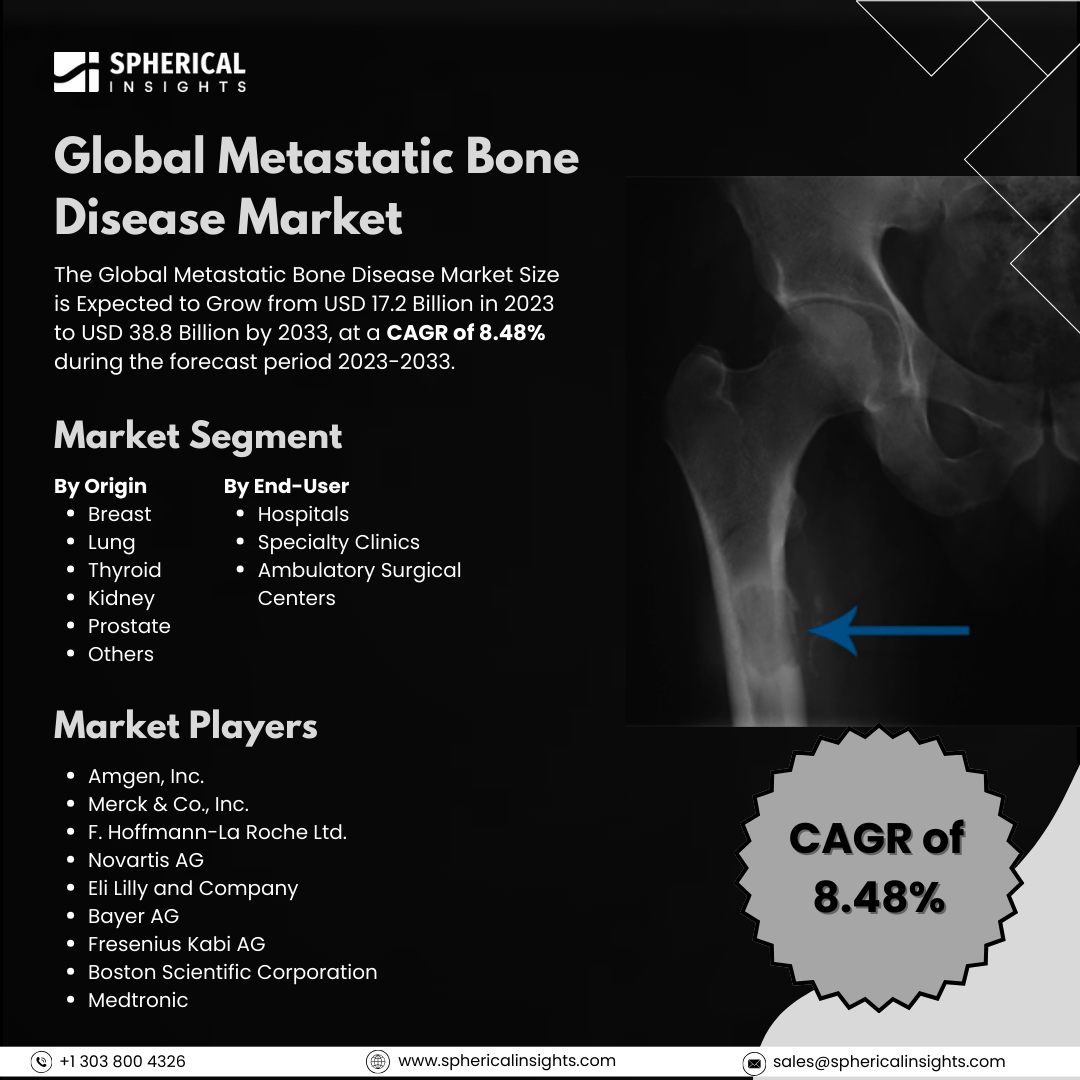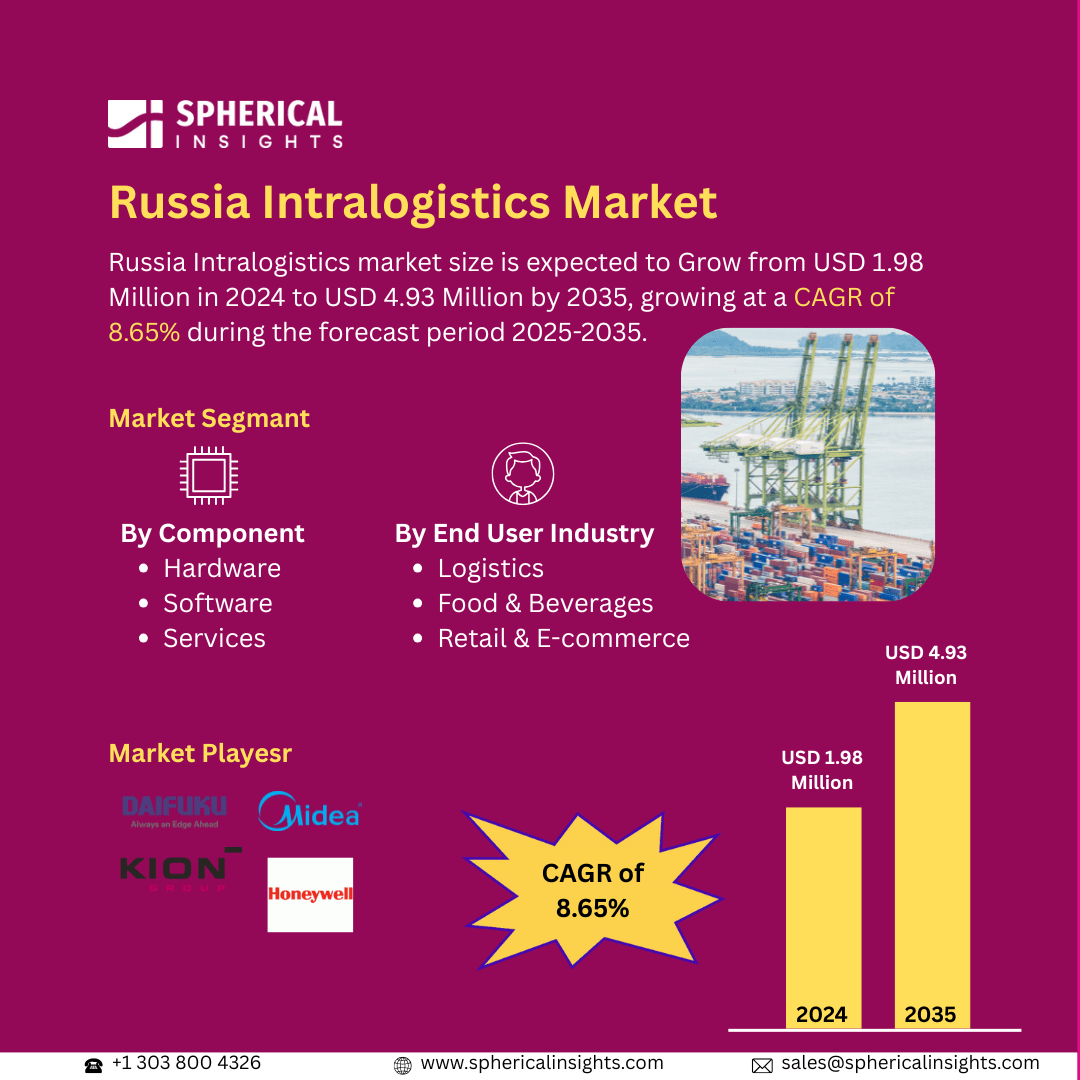Global Metastatic Bone Disease Market Size to Exceed USD 38.8 Billion by 2033
According to a research report published by Spherical Insights & Consulting, The Global Metastatic Bone Disease Market Size is Expected to Grow from USD 17.2 Billion in 2023 to USD 38.8 Billion by 2033, at a CAGR of 8.48% during the forecast period 2023-2033.
Browse 210 market data Tables and 45 Figures spread through 190 Pages and in-depth TOC on the Global Metastatic Bone Disease Market Size, Share, and COVID-19 Impact Analysis, By Treatment Type (Medication [Chemotherapy, Hormone Therapy, Bisphosphonates, Opiate Therapy, and Immunotherapy], Radiation Therapy, Surgical Intervention, and Tumor Ablation Therapy), By Origin (Breast, Lung, Thyroid, Kidney, Prostate, and Others), By End-User (Hospitals, Specialty Clinics, and Ambulatory Surgical Centers), and By Region (North America, Europe, Asia-Pacific, Latin America, Middle East, and Africa), Analysis and Forecast 2023 – 2033
The metastatic bone disease market refers to the global industry focused on the diagnosis, treatment, and management of metastatic bone disease (MBD), a condition where cancer spreads from its original site to the bones. This market includes Pharmaceutical treatments (e.g., bisphosphonates, denosumab, pain management drugs), Radiation therapy (e.g., external beam radiation, radiopharmaceuticals), Surgical interventions (e.g., bone stabilization, tumor excision), and Diagnostic tools. Furthermore, the global metastatic bone disease market is driven by the rising prevalence of cancer, advancements in diagnostic imaging, and improved treatment options like bisphosphonates and targeted therapies. Increasing awareness, growing healthcare expenditures, and technological innovations in radiotherapy and minimally invasive surgeries further fuel market growth. Additionally, an aging population and improved cancer survival rates boost demand for effective MBD management. However, the high treatment costs, limited availability of advanced therapies in developing regions, stringent regulatory approvals, potential side effects of treatments, and late-stage diagnoses reduce treatment effectiveness.
The medication segment accounted for the largest share in 2023 and is anticipated to grow at a significant CAGR during the forecast period.
On the basis of the treatment type, the global metastatic bone disease market is divided into medication, radiation therapy, surgical intervention, and tumor ablation therapy. The medication segment is divided into chemotherapy, hormone therapy, bisphosphonates, opiate therapy, and immunotherapy. Among these, the medication segment accounted for the largest share in 2023 and is anticipated to grow at a significant CAGR during the forecast period. The segmental growth is attributed to the widespread use of bisphosphonates, denosumab, and pain management drugs for metastatic bone disease treatment. Rising cancer cases, advancements in drug formulations, and increasing patient preference for non-invasive treatments drive significant CAGR growth during the forecast period.
The breast segment accounted for the greatest share in 2023 and is anticipated to grow at a substantial CAGR over the forecast period.
On the basis of the origin, the global metastatic bone disease market is divided into breast, lung, thyroid, kidney, prostate, and others. Among these, the breast segment accounted for the greatest share in 2023 and is anticipated to grow at a substantial CAGR over the forecast period. The segmental growth is attributed to the high prevalence of breast cancer and its strong tendency to metastasize to bones. Advancements in early detection, improved treatment options, and increasing awareness drive substantial CAGR growth. Rising healthcare investments and targeted therapies further contribute to market expansion over the forecast period.
The hospitals segment accounted for the largest share in 2023 and is anticipated to grow at a remarkable CAGR during the forecast period.
On the basis of the end-user, the global metastatic bone disease market is divided into hospitals, specialty clinics, and ambulatory surgical centers. Among these, the hospitals segment accounted for the largest share in 2023 and is anticipated to grow at a remarkable CAGR during the forecast period. The segmental growth is attributed to the availability of advanced diagnostic and treatment facilities for metastatic bone disease. Increasing hospital admissions, access to specialized oncology care, and rising adoption of targeted therapies drive remarkable CAGR growth. Government initiatives and improved healthcare infrastructure further boost market expansion over the forecast period.
North America is projected to hold the largest share of the global metastatic bone disease market over the forecast period.
North America is projected to hold the largest share of the global metastatic bone disease market over the forecast period. This is due to its advanced healthcare infrastructure, high cancer prevalence, and strong presence of leading pharmaceutical companies. Increased R&D investments, early disease detection initiatives, and access to innovative treatments further drive market growth. Favorable reimbursement policies and government support ensure the region's largest market share over the forecast period.
Asia Pacific is expected to grow at the fastest CAGR growth of the global metastatic bone disease market during the forecast period. This is due to rising cancer prevalence, improving healthcare infrastructure, and increasing awareness of metastatic bone disease. Expanding access to advanced treatments, government initiatives, and growing investments in pharmaceutical R&D further drive market growth. Additionally, a large patient pool and economic development boost regional market expansion.
Company Profiling
Major vendors in the global metastatic bone disease market are Amgen, Inc., Merck & Co., Inc., F. Hoffmann-La Roche Ltd., Novartis AG, Eli Lilly and Company, Bayer AG, Fresenius Kabi AG, Boston Scientific Corporation, Medtronic, and others.
Key Target Audience
- Market Players
- Investors
- End-users
- Government Authorities
- Consulting and Research Firm
- Venture capitalists
- Value-Added Resellers (VARs)
Recent Development
- In November 2023, to expand its product line, Telix offered US$33.0 million to purchase Qsam Biosciences and add a phase 1 bone cancer radiopharmaceutical. The medication helps treat cancer from the breast, lung, prostate, and other organs that have spread to the bone.
Market Segment
This study forecasts revenue at global, regional, and country levels from 2023 to 2033. Spherical Insights has segmented the global metastatic bone disease market based on the below-mentioned segments:
Global Metastatic Bone Disease Market, By Treatment Type
- Medication
- Chemotherapy
- Hormone Therapy
- Bisphosphonates
- Opiate Therapy
- Immunotherapy
- Radiation Therapy
- Surgical Intervention
- Tumor Ablation Therapy
Global Metastatic Bone Disease Market, By Origin
- Breast
- Lung
- Thyroid
- Kidney
- Prostate
- Others
Global Metastatic Bone Disease Market, By End-User
- Hospitals
- Specialty Clinics
- Ambulatory Surgical Centers
Global Metastatic Bone Disease Market, By Regional
- North America
- Europe
- Germany
- UK
- France
- Italy
- Spain
- Russia
- Rest of Europe
- Asia Pacific
- China
- Japan
- India
- South Korea
- Australia
- Rest of Asia Pacific
- South America
- Brazil
- Argentina
- Rest of South America
- Middle East & Africa
- UAE
- Saudi Arabia
- Qatar
- South Africa
- Rest of the Middle East & Africa



